
Thaxted is a town and civil parish in the Uttlesford district of north-west Essex, England. The town is in the valley of the River Chelmer, not far from its source in the nearby village of Debden, and is 97 metres above sea level. The town is 15 miles (24 km) north from the county town of Chelmsford, and 5.5 miles (9 km) east from the M11 motorway. The parish contains the hamlets of Cutlers Green, Bardfield End Green, Sibleys Green, Monk Street, and Richmond's Green. Much of its status as a "town" rests on its prominent late medieval guildhall, a place where guilds of skilled tradesmen regulated their trading practices, and its English Perpendicular parish church.

Conrad le Despenser Roden Noel was an English priest of the Church of England. Known as the 'Red Vicar' of Thaxted, he was a prominent Christian socialist.

John Webb’s or Lowe’s Mill is a Grade II* listed tower mill at Thaxted, Essex, England, which had been restored to working order, but is currently out of action following the loss of a sail in April 2010.
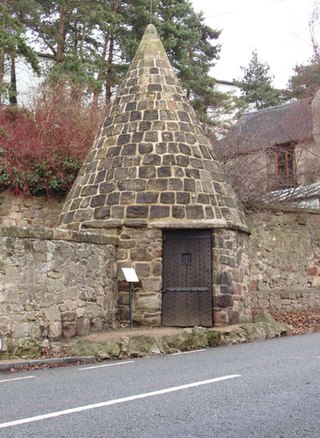
A village lock-up is a historic building once used for the temporary detention of people in England and Wales, mostly where official prisons or criminal courts were beyond easy walking distance. Lockups were often used for the confinement of drunks, who were usually released the next day, or to hold people being brought before the local magistrate. The archetypal form comprises a small room with a single door and a narrow slit window, grating or holes. Most lock-ups feature a tiled or stone-built dome or spire as a roof and are built from brick, stone and/or timber.

Northampton Guildhall is a municipal building in St Giles' Square in Northampton, England. It is a Grade II* listed building.

Matching is a village and civil parish in the Epping Forest district of Essex, England centred in countryside 3 miles (4.8 km) east of Harlow's modern town centre and 2 miles (3.2 km) from Old Harlow/Harlow Mills area of the town. The terrain is elevated and London is centred 21.7 miles (34.9 km) to the south-west.
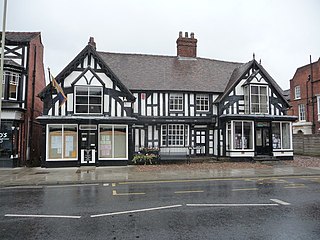
Newport Guildhall is a large timber-framed municipal building in Newport, Shropshire, England. It is a Grade II* listed building.

Horham Hall may refer to the timber-framed late mediaeval hall in Thaxted, England, or to the brick hall built in its place by Sir John Cutte in the early 16th century.

Exeter Guildhall on the High Street of Exeter, Devon, England has been the centre of civic government for the city for at least 600 years. Much of the fabric of the building is medieval, though the elaborate frontage was added in the 1590s and the interior was extensively restored in the 19th century. It is a Grade I listed building.

The Guildhall is a historic building in Bore Street in Lichfield, Staffordshire in the United Kingdom. The guildhall is a Grade II listed building.
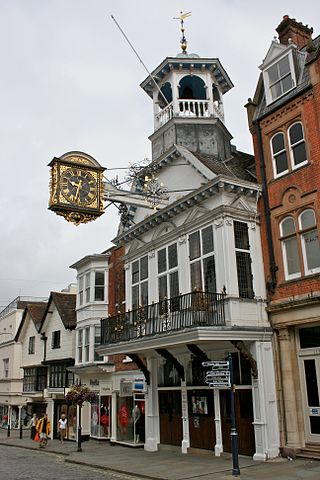
The Guildford Guildhall is a Guildhall located on the High Street of the town of Guildford, Surrey. It is a Grade I listed building.

Essex County Hall is a municipal building in Market Road, Chelmsford, Essex: it is the headquarters of Essex County Council. Blocks C and D are Grade II listed buildings.

The Worcester Guildhall is a municipal building in the High Street, Worcester, England. It is a Grade I listed building.

Gloucester Guildhall is a former municipal building in Eastgate Street, Gloucester, which is now used as a arts and theatre venue. It is a Grade II listed building.

Stratford-upon-Avon Guildhall is a municipal building in Church Street, Stratford-upon-Avon, Warwickshire, England. It is a Grade I listed building.

The Church of Saint John the Baptist with Our Lady and Saint Laurence is the parish church of the town of Thaxted in Essex, England. The present church was built over an extended period between c. 1380 and 1510 in the English Perpendicular style. Sitting on top of a hill with a slender spire reaching 181 feet (55 m) high, the church is one of the largest in the county, overlooking the town and the surrounding countryside. Its size is an indication of the former prosperity of the town, because of the medieval cutlery and wool trades that once flourished here. The church has earned the epithet "the Cathedral of Essex". The church is a Grade I Listed Building on the National Heritage List.
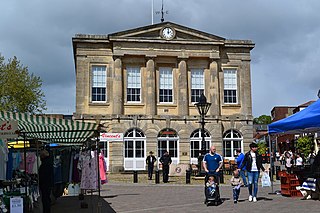
Andover Guildhall is a municipal building in the High Street, Andover, Hampshire, England. The guildhall, which was the headquarters of Andover Borough Council, is a Grade II* listed building.

Evesham Town Hall is a municipal structure in the Market Place in Evesham, Worcestershire, England. The town hall, which was the headquarters of Evesham Borough Council, is a Grade II listed building.
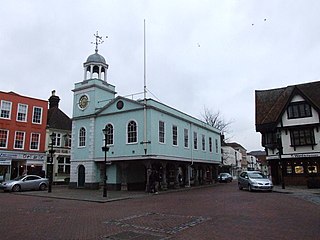
Faversham Guildhall is a municipal building in the Market Place in Faversham, Kent, England. The structure, which was the meeting place of Faversham Borough Council, is a Grade II* listed building.
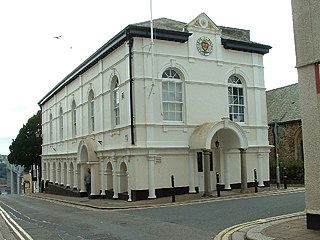
Saltash Guildhall is a municipal building in Fore Street, Saltash, Cornwall, England. The structure, which was the meeting place of Saltash Borough Council, is a Grade II listed building.





















